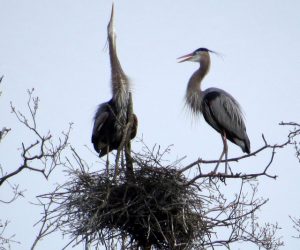
The Catawba River Basin is an important habitat for many aquatic and terrestrial species in North and South Carolina. As the river flows toward the Atlantic Ocean, it is fed by many tributaries and, as discussed above, concentrates in several lakes and reservoirs because of the construction of dams. These features make for a diverse environment that is inhabited not only by many commonly occurring species, such as great blue heron and bluegill, but also several rare or vulnerable species, such as the endangered Carolina Heelsplitter mussel (Lasmigona decorata). A few species are particularly relevant to this discussion because they can be observed as indicators of water quality.
Mussels, which inhabit many regions in the Catawba River and its reservoirs, are filter feeders that use gills to sift large amounts of water for tiny food particles, such as bacteria, algae, and diatoms. Under natural conditions, the filtering action of mussels helps to reduce sedimentation and cloudiness; the gif below features the filtering capabilities of oysters, another important filter feeder in coastal regions, and is comparable of the action of mussels.

These organisms, however, are very sensitive to changes in their environment, and their impairment often accompanies temperature changes, shifts in pH, or decrease in overall water quality. When a region shows a reduction in mussel population, this is an indicator of water quality (2008). The Carolina Heelsplitter, mentioned above, is endangered along approximately 50% of the Catawba River, from Mecklenburg County, NC to Richland County, SC. The status of this species can largely be attributed to habitat loss and water pollution, stemming from several sources. Sedimentation from stormwater and agricultural runoff is the greatest concern for aquatic species, especially organisms like mussels that inhabit river and lake beds, for it has the potential to result in harmful chemical build up, eutrophication, and overall decrease in water quality.
Sources
“Catawba River Basin.” North Carolina Environmental Education. Ed. Carla Burgess. 2013. Web.
“The Endangered River.” Catawba Riverkeeper. Waterkeeper Alliance, n.d. Web. 27 April 2016.